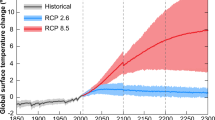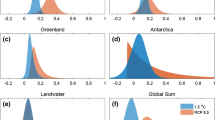Abstract
Projections of climate change are inherently uncertain, leading to considerable debate over suitable allowances for future changes such as sea-level rise (an ‘allowance’ is, in this context, the amount by which something, such as the height of coastal infrastructure, needs to be altered to cope with climate change). Words such as ‘plausible’ and ‘high-end’ abound, with little objective or statistically valid support. It is firstly shown that, in cases in which extreme events are modified by an uncertain change in the average (e.g. flooding caused by a rise in mean sea level), it is preferable to base future allowances on estimates of the expected frequency of exceedances rather than on the probability of at least one exceedance. A simple method of determining a future sea-level rise allowance is then derived, based on the projected rise in mean sea level and its uncertainty, and on the variability of present tides and storm surges (‘storm tides’). The method preserves the expected frequency of flooding events under a given projection of sea-level rise. It is assumed that the statistics of storm tides relative to mean sea level are unchanged. The method is demonstrated using the GESLA (Global Extreme Sea-Level Analysis) data set of roughly hourly sea levels, covering 198 sites over much of the globe. Two possible projections of sea-level rise are assumed for the 21st century: one based on the Third and Fourth Assessment Reports of the Intergovernmental Panel on Climate Change and a larger one based on research since the Fourth Assessment Report.




Similar content being viewed by others
References
Bindoff N, Willebrand J, Artale V, Cazenave A, Gregory J, Gulev S, Hanawa K, Quéré CL, Levitus S, Nojiri Y, Shum C, Talley L, Unnikrishnan A (2007) Climate change 2007: the physical science basis. Contribution of working group I to the fourth assessment report of the Intergovernmental Panel on Climate Change, chap 5. Cambridge University Press, Cambridge, pp 385–432
Church J, White N (2011) Sea-level rise from the late 19th to the early 21st century. Surv Geophys. doi:10.1007/s10712-011-9119-1, published online: 30 March 2011
Church J, Gregory J, Huybrechts P, Kuhn M, Lambeck K, Nhuan M, Qin D, Woodworth P (2001) Climate change 2001: the scientific basis. Contribution of working group 1 to the third assessment report of the Intergovernmental Panel on Climate Change, chap 11. Cambridge University Press, Cambridge, pp 639–693
Coles S (2001) An introduction to statistical modeling of extreme values. Springer, London
Hunter J (2010) Estimating sea-level extremes under conditions of uncertain sea-level rise. Clim Change 99(3):331–350. doi:10.1007/s10584-009-9671-6
Le Quéré C, Raupach M, Canadell J, Marland G et al (2009) Trends in the sources and sinks of carbon dioxide. Nature Geoscience 2:831–836. doi:10.1038/ngeo689
Meehl G, Stocker T, Collins W, Friedlingstein P, Gaye A, Gregory J, Kitoh A, Knutti R, Murphy J, Noda A, Raper S, Watterson I, Weaver A, Zhao ZC (2007) Climate change 2007: the physical science basis. Contribution of working group I to the fourth assessment report of the Intergovernmental Panel on Climate Change, chap 10. Cambridge University Press, Cambridge, pp 747–845
Menéndez M, Woodworth P (2010) Changes in extreme high water levels based on a quasi-global tide-gauge data set. J Geophys Res 115(C10011). doi:10.1029/2009JC005997
Nicholls R, Marinova N, Lowe J, Brown S, Vellinga P, de Gusmão D, Hinkel J, Tol R (2011) Sea-level rise and its possible impacts given a ‘beyond 4°C world’ in the twenty-first century. Phil Trans R Soc A 369:161–181. doi:10.1098/rsta.2010.0291
Pfeffer W, Harper J, O’Neel S (2008) Kinematic constraints on glacier contributions to 21st-century sea-level rise. Science 321(5894):1340–1343. doi:10.1126/science.1159099
Pugh D (1996) Tides, surges and mean sea-level. Wiley, Chichester. Reprinted with corrections, http://eprints.soton.ac.uk/19157/01/sea-level.pdf
Pugh D (2004) Changing sea levels: effects of tides, weather, and climate. Cambridge University Press, Cambridge
R Development Core Team (2008) R: a language and environment for statistical computing. R Foundation for Statistical Computing, Vienna, Austria. http://www.R-project.org, ISBN 3-900051-07-0
Rahmstorf S, Cazenave A, Church J, Hansen J, Keeling R, Parker D, Somerville R (2007) Recent climate observations compared to projections. Science 316(5825):709. doi:10.1126/science.1136843
van den Brink H, Können G (2011) Estimating 10000-year return values from short time series. Int J Climatol 31:115–126. doi:10.1002/joc.2047
Woodworth P, Blackman D (2004) Evidence for systematic changes in extreme high waters since the mid-1970s. J Climate 17(6):1190–1197. doi:10.1175/1520-0442(2004)017<1190:EFSCIE>2.0.CO;2
Acknowledgements
This paper was supported by the Australian Government’s Cooperative Research Centres Programme through the Antarctic Climate & Ecosystems Cooperative Research Centre. Sea-level data were supplied by European Sea-Level Service, Global Sea Level Observing System (GLOSS) Delayed Mode Centre, Helpdesk Water (Netherlands), Instituto Español de Oceanographia (Spain), Istituto Talassografico di Trieste (Italy), Marine Environmental Data Service (Canada), National Oceanography Centre Liverpool (UK), National Tidal Centre (Bureau of Meteorology, Australia), Norwegian Mapping Authority, Service Hydroographique et Océanographique de la Marine (France), Swedish Meteorological and Hydrological Institute and University of Hawaii Sea Level Centre (USA).
Author information
Authors and Affiliations
Corresponding author
Electronic Supplementary Material
Below is the link to the electronic supplementary material.
Rights and permissions
About this article
Cite this article
Hunter, J. A simple technique for estimating an allowance for uncertain sea-level rise. Climatic Change 113, 239–252 (2012). https://doi.org/10.1007/s10584-011-0332-1
Received:
Accepted:
Published:
Issue Date:
DOI: https://doi.org/10.1007/s10584-011-0332-1




